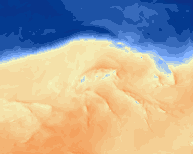
The days of strong high-pressure influence are coming to an end. The new year will start with a more unsettled period. This is being initiated by a cold front coming in from the northwest on Thursday. Chris mentioned the uncertainty of this change in weather two days ago. Today, we will see if we can provide more clarity about the upcoming snowfall.
Thursday cold front
On Thursday during the day, the cold front approaches the Northwestern Alps, but it’s only in the evening that snow will start falling in more places. The warm air and föhn wind on the north side of the front will keep conditions dry for much of the day.

Behind the cold front, the weather will quickly clear up on Friday. So, don’t expect persistent or heavy snowfall, just a few showers. The front will bring 10 to 20 cm of snow to the Northwestern Alps, with a little more in the Swiss northweststau areas.
At higher altitudes, much colder air will move in, about 10 degrees colder. The cold front will be accompanied by increasing wind and strong gusts at higher elevations. The snowline will drop rapidly, reaching below 1000 meters.
Warming up from the west
During the weekend, this cold air will slowly be pushed out from the west. The Western Alps will be the first to experience this change, with light snow possible here. This snow might then move towards the northwestern edge of the Alps on Sunday. The snowline will be much higher due to the warmer air, possibly reaching 1800-2000 meters temporarily.
It’s still uncertain whether the precipitation will mostly skim past the Northwestern Alps or hit them directly. The Northern Alps will warm up on Sunday as well, leading to a weak föhn situation and stronger winds in the inner Alpine areas and on the north side.
Continuing uncertainty after the weekend
Looking beyond the weekend, there’s still a lot of uncertainty in the forecast. We’re checking the main runs from the EC (left) and GFS (right) models (source: wxcharts). The temperatures at around 1500 meters and the sea-level pressure for Monday show significant differences between the models.

The uncertainty is also evident in the ensemble forecasts. EC shows a bifurcation for Geneva from January 7, with one cluster of members indicating much colder temperatures, while another cluster (with the main run) quickly returns to milder conditions. GFS forecasts colder air moving in from the north later in the week. Both models still suggest considerable variability, so we can expect more snow.

Chris will follow up soon with a weather update, hopefully providing more clarity on these developments for next week. For now, have a great New Year’s Eve and a snowy 2025!


